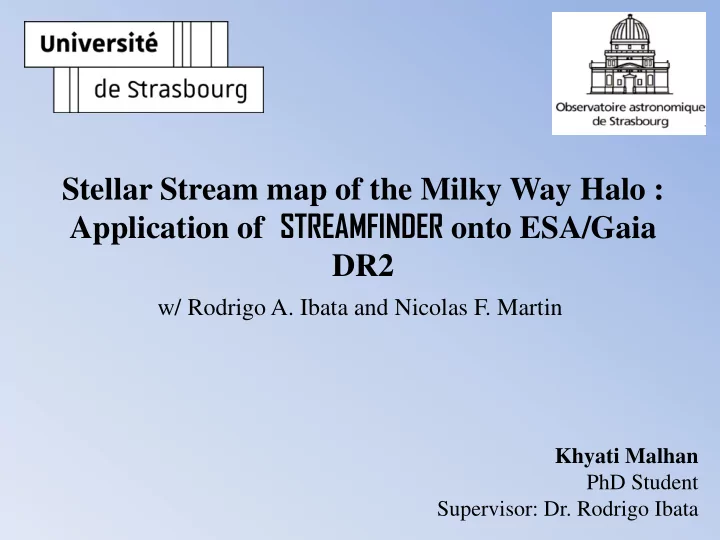

Stellar Stream map of the Milky Way Halo : Application of STREAMFINDER onto ESA/Gaia DR2 w/ Rodrigo A. Ibata and Nicolas F. Martin Khyati Malhan PhD Student Supervisor: Dr. Rodrigo Ibata
Outline • What are stellar streams important? • The STREAMFINDER algorithm. • Stellar Stream maps of the Milky Way halo from ESA/Gaia DR2.
Stellar Streams Pal 5 stream. Discovered by • Odenkirchen et al. (2001). This map was created by Bernard et al (2016)
Stellar Streams >40 Previously discovered Milky Way Streams • Malhan, Ibata & Martin (2018). ZEA projection of the Galactic sky containing all of the known streams Milky Way streams (~40). The plot was created using galstreams package ( Mateu et al 2017 )
Stellar Streams Orbital Structure of Streams Pal 5 stream. Discovered by • Odenkirchen et al. (2001). This map was created by Bernard et al (2016)
Stellar Streams Stellar streams are great archaeological tools : • Constraining the φ MW (x), MW dark-matter distribution, lumpiness of the halo (Ibata et al 2002, Law & Majewski 2010, Koposov et al 2010, Bovy et al 2015, Carlberg 2013, Erkal & Belokurov 2015) • Estimating fundamental parameters ( R sun , V s un ) of the MW Galaxy (Majewski et al 2006, Kupper et al 2015, Malhan & Ibata 2017) • Radial migration process in the disk (Martell et al 2016) • Quantifying pre-merging history of our Galaxy. …..So they are useful. And the more, the merrier.
STREAMFINDER Malhan & Ibata (2018) Maximize stream detection by: • Use all the prior information about the stellar stream (knowledge of phase-space-color-magnitude distribution) • Use all the information delivered by Gaia DR2
STREAMFINDER Malhan & Ibata (2018) Maximize stream detection by: • Use all the prior information about the stellar stream (knowledge of phase-space-color-magnitude distribution) • Use all the information delivered by Gaia DR2 Best way to detect stream : LOOK ALONG THE ORBITS
STREAMFINDER Malhan & Ibata (2018) Maximize stream detection by: • Use all the prior information about the stellar stream (knowledge of phase-space-color-magnitude distribution) • Use all the information delivered by Gaia DR2 Best way to detect stream : LOOK ALONG THE ORBITS……Hmm?
STREAMFINDER Malhan & Ibata (2018) Maximize stream detection by: • Use all the prior information about the stellar stream (knowledge of phase-space-color-magnitude distribution) • Use all the information delivered by Gaia DR2 Assumption : stream members contained in a 6D hypertube and its 6D volume ~ f( σ w , σ v , t orbit )
STREAMFINDER Malhan & Ibata (2018) Testing algorithm with N-body simulated stream • Simulated a globular cluster stream in a realistic galactic model (Dehnen & Binney 1998) • Retained only 50 objects in the stream, Σ G =33 mag arcsec-2 (faint stream) Retained only 4D phase-space information – l , b, μ l , μ b (with errors) • v rad and ω information was deleted. • Convolved Gaia like errors in proper motions. • Also assigned a SSP model to the stream of ([Fe/H], Age)= (-1.5, 10 Gyr)
STREAMFINDER Malhan & Ibata (2018) Testing algorithm with N-body simulated stream PERFECT STREAM GAIA-like ERRORS
STREAMFINDER Malhan & Ibata (2018) • Stream (50 stars) + GUMS (330,000 stars) = Data. 0.015% stream stars. • v rad and ω information was deleted. Convolved Gaia like errors .
STREAMFINDER Malhan & Ibata (2018) Orbit sampling • Blindness and uncertainty in stellar phase-space position. a) Sample orbits in distance space (consistent with a SSP model) b) Sample orbits in v rad space ( v total < v escape ) c) Sample orbits in proper motion space • ~30,000 orbits for every datum. Sampled orbits Perfect orbit Data orbit
STREAMFINDER Malhan & Ibata (2018) • Log-likelihood of a star being associated with a stellar stream. L datum = L kinematics + L LF + L continuity Luminosity Stream continuity Data-orbit comparison Function criteria (given the observed errors) criteria
STREAMFINDER Malhan & Ibata (2018) • Log-likelihood of a star being associated with a stellar stream. L datum = L kinematics + L LF + L continuity Luminosity Stream continuity Data-orbit comparison Function criteria (given the uncertainties) criteria • L acts as ``weight’’ for every star used to obtain stream density plot
STREAMFINDER Malhan & Ibata (2018) • Stream output – loglikelihood density plot
STREAMFINDER Malhan & Ibata (2018) Multiple stream case : • Age = 9-10 Gyrs • [Fe/H] = -1.5 to -2.5 • 50 stars per stream • Surface brightness ~ 33 mag arcsec -2 (very faint)
STREAMFINDER Malhan & Ibata (2018) Multiple stream case : • Age = 9-10 Gyrs • [Fe/H] = -1.5 to -2.5 • 50 stars per stream • Surface brightness ~ 33 mag arcsec -2 (very faint) • STREAMFINDER using different SSP models
MW Stellar Stream map from Gaia DR2 • Gaia DR2 released on 25 April 2018 • 1.7 billion sources down to G~20.7. • Positions +Proper motions+ parallaxes (not so good) +G,BP,RP for all sources.
MW Stellar Stream map from Gaia DR2 Malhan, Ibata & Martin (2018) results…? Gaia DR2 dataset • |b|>30 ◦ STREAMFINDER • GCs and DGs masked
Inner halo . Distance =[5, 15] kpc. Malhan et al (2018)
Observations Orbital Solutions Phase-space-luminosity coherence of the structures. Malhan et al (2018)
Testing the phase-space-luminosity coherence of the structures. Malhan et al (2018)
Intermediate halo . Distance =[15, 30] kpc. Malhan et al (2018)
Inner halo. Distance =[5, 15 kpc]. Malhan et al (2018)
Sgr stream Outer halo. Distance =[20, 100] kpc. Malhan et al (2018)
STREAMFINDER Malhan & Ibata (2018) Main advantages of the algorithm : • Completing the 6D DF(x,v) of detected stellar streams -useful in the context of galaxy formation . • Stream Orbital properties GD-1 stream observations (Koposov et al 2010) STREAMFINDER solutions • ``Chemical tagging’’ of stars based on SSP model. • STREAMFINDER BLOBFINDER (find blob of stars – star clusters and dwarf galaxies)
Recommend
More recommend